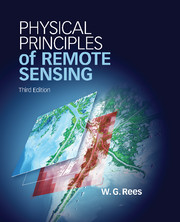Book contents
- Frontmatter
- Contents
- Preface
- Acknowledgements
- 1 Introduction
- 2 Electromagnetic waves in free space
- 3 Interaction of electromagnetic radiation with matter
- 4 Interaction of electromagnetic radiation with the Earth's atmosphere
- 5 Photographic systems
- 6 Electro-optical systems
- 7 Passive microwave systems
- 8 Ranging systems
- 9 Scattering systems
- 10 Platforms for remote sensing
- 11 Data processing
- Appendix Data tables
- References
- Index
- Plate Section
10 - Platforms for remote sensing
Published online by Cambridge University Press: 05 December 2012
- Frontmatter
- Contents
- Preface
- Acknowledgements
- 1 Introduction
- 2 Electromagnetic waves in free space
- 3 Interaction of electromagnetic radiation with matter
- 4 Interaction of electromagnetic radiation with the Earth's atmosphere
- 5 Photographic systems
- 6 Electro-optical systems
- 7 Passive microwave systems
- 8 Ranging systems
- 9 Scattering systems
- 10 Platforms for remote sensing
- 11 Data processing
- Appendix Data tables
- References
- Index
- Plate Section
Summary
In this chapter we consider aircraft and satellites as platforms for remote sensing. There are other, less commonly used, means of holding a sensor aloft, for example towers, balloons, model aircraft and kites, but we do not discuss these. The reason for this, apart from their comparative infrequency of use, is that most remote sensing systems make direct or indirect use of the relative motion of the sensor and the target, and this is more easily controllable or predictable in the case of aircraft and spacecraft. Figure 10.1 shows schematically the range of platforms, and their corresponding altitudes above the Earth’s surface.
The spatial and temporal scales of the phenomenon to be studied will influence the observing strategy to be employed, and this in turn will affect the choice of operational parameters in the case of an airborne observation or of the orbital parameters in the case of a spaceborne observation. After a brief introduction to the use of aircraft as platforms for remote sensing, this chapter focusses on the use of artificial satellites.
- Type
- Chapter
- Information
- Physical Principles of Remote Sensing , pp. 318 - 347Publisher: Cambridge University PressPrint publication year: 2012



